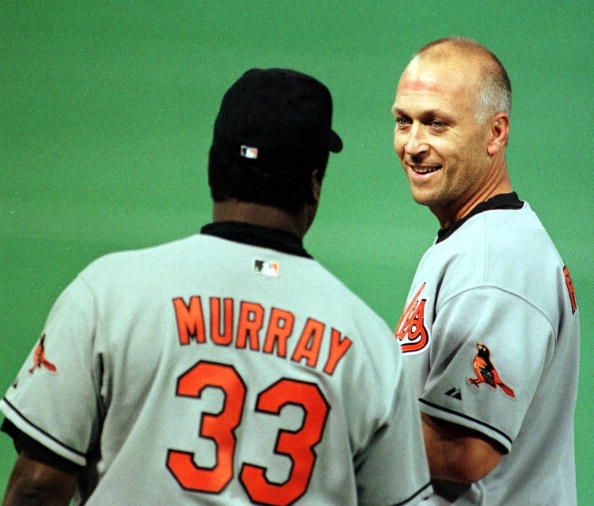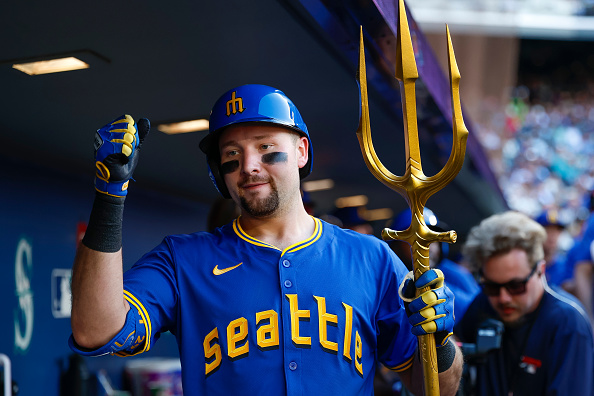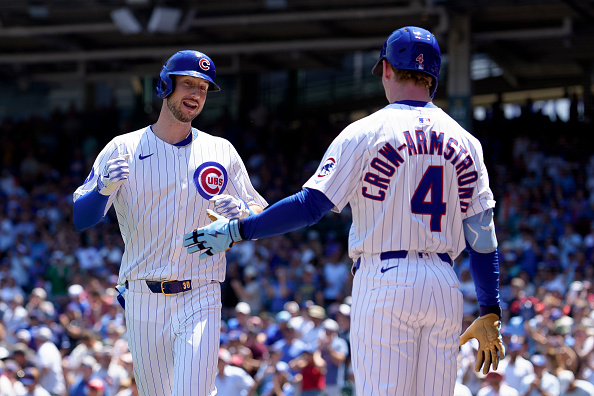Though it may not seem like it now, the history of the Baltimore Orioles is full of great moments and league records. From Cal Ripken Jr.‘s consecutive games played streak to Trey Mancini‘s triumphant return from Stage 3 colon cancer, the Baltimore Orioles have a lot to be proud of from their fraternity.
However, only 26 men can have the honor of being named to their all-time roster.
A franchise began in 1901 as the Milwaukee Brewers, then spent 52 seasons as the St. Louis Browns before making their final branding switch to the Baltimore Orioles in 1954. Now, we take a look at who makes the tough cut.
Make sure to check out all of our other All-Time Rosters.
Starting Nine
Chris Hoiles, C
Hoiles spent a decade in Baltimore from 1989 until 1998. While his career wasn’t at a Hall of Fame level, he managed to put up 4.6 WARP––Baseball Prospectus wins above replacement––per 150 games over his career. On top of that, he ranks third among Orioles catchers in wRC+ (122), is first in home runs (151), first in fWAR (24.8), and second in slugging percentage (.467).
He didn’t have the flashiest career, but being 22 percent above league average while being the franchise leader in fWAR is incredibly impressive.
Eddie Murray, 1B
Murray was a bit of a no-brainer for the first base position. Not only is he the leader in fWAR among Orioles’ first basemen, but he’s also third among all players in franchise history in that statistic.
On top of that, he slashed .294/.370/.498 with a wRC+ that ranked tied for sixth in franchise history (137).
In 13 years in Baltimore, Murray accumulated 2,080 hits (fourth), 343 home runs (second), 1,224 runs batted in (third), made seven All-Star teams and won Rookie of the Year. He also had 10 seasons of at least 25 home runs and five seasons of 110 or more runs batted in.
The Hall of Fame first baseman may have found some success as a Dodger for three years after leaving the Orioles, but there’s no question that the switch-hitter will always be remembered for what he did as a member of the Birds.
Bobby Grich, 2B
The second base position was the first that was up for debate. Though Hall of Famer Roberto Alomar spent three All-Star seasons in Baltimore, he didn’t quite make the cut. Brian Roberts ranks third in the franchise’s history for stolen bases and was second in fWAR for second basemen, but he wasn’t good enough to usurp one of the greatest Hall of Fame snubs to date.
Although many may remember him for his days with the Angels, Grich spent his first seven seasons in Baltimore. In those seven years, he accumulated 33.6 fWAR (first among Orioles second-baseman), played at a 6.4 fWAR/150 pace, won four straight Gold Gloves, and went to three out of five All-Star Games from 1972 to 1976.
Grich had a better career in his decade with the Angels but was easily the best second baseman in team history.
Cal Ripken Jr., SS
This one needs no real explanation. Ripken is the franchise leader in fWAR (92.5), home runs (431), hits (3,184), games played (3,001), and runs batted in (1,695).
Ripken also owns the record for the longest run of consecutive games played at 2,632––beating the original Iron Horse’s––Lou Gehrig––streak that lasted 56 years. Not to mention 19 All-Star Game selections, two MVP awards, eight Silver Sluggers, two Gold Gloves, and Rookie of the Year victory.
Ripken has an incredibly decorated career, and deservedly so.
Manny Machado, 3B
This one might come under fire, but there’s more than enough reason to believe Machado is the best third baseman Baltimore has ever had.
Machado: .279/.338/.487, 120 wRC+, .349 wOBA, 4.6 fWAR/150, 28.9 HR/150, 86.3 RBI/150, 8.0 walk rate
Robinson: .267/.322/.401, 104 wRC+, .322 wOBA, 4.2 fWAR/150, 13.9 HR/150, 70.3 RBI/150, 7.3 walk rate
Machado also had an incredibly decorated career in Baltimore, winning three Gold Gloves, finishing top five in MVP voting twice, and making it to four All-Star Games. Despite winning more Gold Gloves, taking home an MVP, and making many more All-Star Games, Robinson isn’t better than Machado across the board.
Robinson is a Hall of Famer and, to foreshadow, isn’t missing the cut on this roster. However, the better player needs to be the starter.
Ken Williams, LF
Williams played for the Orioles from 1918 until 1927, when they were the St. Louis Browns. During that time, he didn’t win a single award and never made an All-Star Game.
However, he had an incredibly productive career for the Browns. In a decade, he slashed .326/.403/.558 with a 141 wRC+. That 141 wRC+ ranks first among Orioles left fielders, as does his .435 wOBA and .558 slugging percentage.
He’s second to Boog Powell in fWAR, but his fWAR/150 was 5.2 to Powell’s 3.4––therefore giving him the edge.
Paul Blair, CF
Apart from being the franchise leader for center fielders in fWAR, Blair is the best defensive center fielder in team history regarding defensive value on FanGraphs (157.1). The next closest is Mike Devereaux (30.7).
Blair had an OK offensive career, posting a 101 wRC+ in 13 seasons, but his calling was definitely on the defensive side of the ball––taking home eight Gold Glove awards. He also made two All-Star Games and finished top 15 in MVP voting twice in 1969 and 1974.
Frank Robinson, RF
Another one that needs no real explanation. Robinson leads all Orioles right fielders in fWAR (33.4), wRC+ (168), wOBA (.415), slugging percentage (.543) and on-base percentage (.401).
Couple his fWAR lead with him being closer to 20th in games played at the position than first, and there’s no real question who is deserving of that status.
Being a six-win ballplayer per 150 games over six seasons is great, then you add in his MVP and five All-Star selections and there’s even less of a debate.
Chris Davis, DH
What happened to Davis post-2016 is incredibly tragic. However, from 2012 to 2016, he was in a league of his own offensively.
In 3,095 plate appearances during that stretch, the slugger slashed .249/.340/.518 with a 131 wRC+. While 2017 to 2020 were forgettable at the least, Davis had perhaps one of the best peaks of the 2010s.
During that five-year period from 2012 to 2016, he led all of baseball in home runs (197) and was ninth in hard-hit rate (38.9 percent).
Coming up with the pitchers was much more difficult to weigh. When there’s a lot of roster turnover in the rotation, it’s hard to balance volume with short-term production.
However, who did make the cut as the Orioles’ best pitchers of all time?
Rotation
Jim Palmer, RHP
In a group full of decisions, this one was the easiest to make. From 1969 to 1982, Palmer won 240 games, logged 203 complete games, pitched over 3,500 innings, and had an ERA+ of 131.
He also won three Cy Young Awards, three World Series titles and was a part of the 1971 Orioles rotation that had four 20-game winners.
He is the franchise leader in fWAR for starting pitchers, first in strikeouts (2,124), and is fourth in ERA (min, 1,500 innings). About as big a no-brainer as you can get from an all-time starting pitcher.
Mike Mussina, RHP
Mussina spent the first 10 seasons of an 18-year career with the Orioles, tallying 147 wins in the process. Though his career will be remembered mostly for what happened in the Bronx, Mussina still had a dominant career in Baltimore.
In 288 appearances, the right-hander posted a FIP of 3.63, an ERA of 3.53, and had 1,532 strikeouts in over 2,000 innings.
Mussina also made five All-Star teams and won four Gold Gloves in his Orioles career, while finishing in the top five in Cy Young voting five times as well. Mussina is right up there with Palmer, Ripken, Murray, and Frank Robinson in terms of the biggest no-brainer, slam dunk members of this roster.
Erik Bedard, LHP
This is where making decisions gets a little difficult. Bedard isn’t in the top 20 for Orioles starters in terms of fWAR, nor is he in the top 60 for innings pitched. That being said, the southpaw had such a good career in Baltimore that he becomes hard to overlook.
Bedard spent four seasons––plus two-thirds of an inning––with the Orioles and continued to get better each and every year. In fact, in his final two seasons in Baltimore, he posted consecutive seasons of at least 4.6 fWAR. The latter of the two seasons (2007) saw him finish top five in American League Cy Young voting.
Among every qualifying starter with a measurable strikeout rate in team history, Bedard ranks second with a 22.7 percent strikeout rate. He also posted a 3.59 FIP, a 3.87 SIERA and kept hard contact to a minimum (26.8 percent).
He had an incredibly overlooked career in Baltimore, as the team was in a perpetual rebuild. But he deserves to be on this list, despite logging fewer than 700 innings for the team.
Dave McNally, LHP
McNally spent all but one season of his big-league career with the Orioles. In that time, he made three All-Star Games, was top five in Cy Young voting three times and was once top five in MVP voting.
Like Palmer, McNally also was a part of that 1971 rotation that featured four 20-game winners.
Though that team didn’t win the World Series, McNally did take home two World Series rings and is ultimately third in franchise history in fWAR (first for lefties).
McNally posted a 3.18 ERA with the Birds, as well as a 3.46 FIP. While his strikeouts-per-nine innings were only a tick over five, he still struck out 1,476 hitters in his Orioles career.
Mike Flanagan, LHP
Rounding out the rotation is left-hander Flanagan. Flanagan’s career wasn’t overly decorated, as he won one Cy Young and made just one All-Star team––not in the same season.
However, his career did yield a World Series title with the Orioles back in 1983, where he pitched nine innings across two starts, allowing three earned runs.
Moreover, Flanagan is fifth in Orioles history in wins (139), is fourth in fWAR (31.5), and was staked to a 3.79 FIP in 15 seasons.
Bullpen
Zack Britton, LHP
Britton had one of the single-most dominant seasons in MLB history for a reliever in 2016, posting a 0.54 ERA and a 1.94 FIP to complement his 29.1 strikeout rate.
Britton made two All-Star Games, had a top-five finish in Cy Young voting in 2016, and had a sub-two ERA as a reliever for the Orioles.
His career began as a starter that couldn’t find consistency, but he put it together in a big way to help the Orioles be one of the imposing threats in the American League during the mid-2010s.
Gregg Olson, RHP
Olson is Baltimore’s franchise leader in fWAR for a reliever, despite only spending six seasons there.
In those six seasons, he posted a 2.26 ERA, a franchise-leading 2.61 FIP, and saves (160), and had a 176 ERA+.
He was incredibly dependable his entire time there, as his worst full season saw him sporting a 2.71 FIP.
Jim Johnson, RHP
Johnson had consecutive 50-save seasons in 2012 and 2013 and is also the No. 3 placeholder for saves in franchise history.
While he didn’t rack up the strikeouts like a lot of modern-day closers, Johnson was able to post a 3.49 FIP and a 146 ERA+ as an Orioles reliever from 2007 to 2013.
Johnson made an All-Star team once as well, in a season he struck out just 15.2 percent of hitters.
Darren O’Day, RHP
The submarine-style right arm of O’Day was a thorn in the side of opposing hitters his entire Orioles career.
From 2012 to 2018, O’Day posted a 2.79 SIERA, struck out 28.4 percent of batters, and pitched to the tune of a 3.33 FIP. The fact he only made one All-Star Game is one of the greater examples of middle-reliever bias in roster construction.
His 6.1 fWAR is seventh among Orioles relievers ever, and his FIP is 18th. He, coupled with Britton, really gave the American League East trouble in that 2014 to 2017 window where Baltimore was knocking on the door of being an elite team.
B.J. Ryan, LHP
Ryan has the third-most fWAR among relievers in Baltimore Orioles history. In his final two seasons with the team, he posted a 2.35 ERA, a 2.10 FIP, a 2.31 SIERA, a 2.53 xFIP, and a strikeout rate of 34.1 percent.
He truly popped his final two seasons in Baltimore, carrying that to his first of two All-Star Game selections in 2005. That year also saw him take ownership of the closer role, where he locked down 36 saves in 41 attempts.
Tippy Martinez, LHP
Martinez is second in fWAR among all Orioles relievers, and his career with them spanned from 1976 to 1986.
In his 11-year career with Baltimore, Martinez had a 3.46 ERA, a 3.48 FIP, and the fourth-most saves in team history with 105.
He wasn’t overly dominant, striking out only about seven percent more batters than he walked, but he was dependable at the very least.
His best season was in 1979, where he had a 2.88 ERA, a 2.40 FIP, and struck out 19.2 percent of batters faced. However, his one All-Star season was in 1983, where he also helped the Orioles win the World Series.
Hoyt Wilhelm, RHP
The Hall of Famer, Wilhelm, was a right-hander who spent four-plus seasons with the Orioles from 1959 to 1963. In that span, he was a Swiss Army Knife for them.
He made 185 appearances, 43 starts, had 40 saves, but also pitched 19 complete games.
In that span, he logged a 2.42 ERA and a 2.94 FIP.
Stu Miller, RHP
Miller rounds out the bullpen, especially considering how good he was for the Orioles as an age 35-to-39-year-old.
From 1963 to 1967, Miller posted a 2.37 ERA, a 2.64 FIP, a 21.4 percent strikeout rate, and had an ERA+ of 145.
On top of that, Stu Miller is fifth all-time in saves for the Orioles franchise, with exactly 100. He’s also fifth in ERA, third in FIP, and tied for 17th in strikeout rate. While the latter of those three numbers isn’t exactly in the top tier for Orioles relievers, he was excellent in terms of run prevention, which gives him the edge as it is.
Bench
Brooks Robinson, 3B
There he is.
You can’t write the story of the Orioles franchise without mentioning Brooks Robinson. The only reason he wasn’t the starting third baseman is that Machado had him beat on a rate basis across the board.
Objectively, these were the only two choices for third base, and both had to be on the roster. Especially Robinson, who is second all-time in Orioles history with 80.2 fWAR, trailing only Cal Ripken Jr.
George Sisler, 1B
If not for Murray being the caliber player he was, Sisler would’ve easily been the first baseman for the numbers he put up for the St. Louis Browns.
From 1915 to 1927, Sisler slashed .344/.384/.481 with a 129 wRC+ and a .402 wOBA. Ultimately, his wOBA and OBP were both higher than Murray’s, but Murray hit 250 more home runs and bested him in total fWAR.
Ken Singleton, OF
Singleton had a wonderful career in Baltimore, posting a 137 wRC+ across 6,072 plate appearances. He also walked more than he struck out and carried an on-base percentage of .388 for his Orioles career.
Defensively, he doesn’t rate very well. However, he’s fifth in offensive value in Orioles history.
Brady Anderson, OF
Anderson had one of the most interesting careers of all Orioles players.
His home runs by season after arriving in Baltimore went one, four, three, two, 21, 13, 12, 16, 50, 18, 18, 24, 19, and eight.
Anderson randomly had a 50-homer season sandwiched in the heart of his career in Baltimore. While that’s not indicative of how much power he had overall, that season can’t be ignored when talking about the history of the Orioles.
Honorable Mentions:
Cedric Mullins, OF
Trey Mancini, 1B/DH/OF
Urban Shocker, RHP
Mike Cuellar, LHP
Brian Roberts, 2B
Check us out on our socials:
Twitter: @PTSTNews and @TalkPrimeTime
Facebook Page: Prime Time Sports Talk
Join our Facebook Group: Prime Time Sports Talk
Instagram: @ptsportstalk
Follow Jordan Leandre on Twitter: @JordanLeandre55
Main Image Credit: Embed from Getty Images








One Response